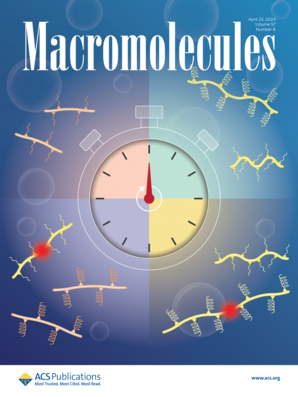Nanoscale Morphology in Disodium Salt-Anchored Polyethylene Ionomers
IF 5.1
1区 化学
Q1 POLYMER SCIENCE
引用次数: 0
Abstract
A molecular-level understanding of the ion cluster morphology is crucial to designing the structure and enhancing the properties of random polyethylene ionomer. Here, we report that the strategic addition of aliphatic disodium salt has a pronounced effect on the mechanical properties and nanoscale morphology. With the addition of various aliphatic disodium salts, both the tensile strength and Young’s modulus are significantly increased. By comparing the results of atomistic molecular dynamics simulations with experimental characterization data, the ionic cluster nanoscale morphology varies with different chain-length disodium salts, while maintaining the crystallization of the polyethylene matrix. The alkyl disodium salts with relatively short alkyl chains (<C8) tend to anchor to the same cluster, forming encapsulation or loop structure. The alkyl disodium salts with relatively long alkyl chains (>C12) bridge between clusters by anchoring to two different clusters, helping to redistribute the clusters within the polymer matrix and providing additional cross-link strength. The cluster morphological evolution during stretching was simulated, and its relation to mechanical properties is comprehensively discussed. This, in turn, unlocks the potential for structural regulation at the nanoscale by additive manufacturing to enhance the performance.

二钠盐锚定聚乙烯离聚体的纳米级形貌
在分子水平上理解离子簇的形态对于设计无规聚乙烯离聚体的结构和提高其性能至关重要。在这里,我们报道了脂肪族二钠盐的策略添加对机械性能和纳米级形貌有显著的影响。随着各种脂肪族二钠盐的加入,材料的抗拉强度和杨氏模量均有显著提高。通过原子分子动力学模拟结果与实验表征数据的比较,离子簇纳米尺度形貌随二钠盐链长度的不同而变化,同时保持聚乙烯基体的结晶性。具有较短烷基链(<C8)的烷基二钠盐倾向于锚定在同一簇上,形成包封或环状结构。具有较长烷基链(>C12)的烷基二钠盐通过锚定在两个不同的簇之间建立桥接,有助于在聚合物基体中重新分配簇,并提供额外的交联强度。模拟了拉伸过程中团簇形态的演变,并对其与力学性能的关系进行了全面讨论。这反过来又释放了通过增材制造在纳米尺度上进行结构调节的潜力,以提高性能。
本文章由计算机程序翻译,如有差异,请以英文原文为准。
求助全文
约1分钟内获得全文
求助全文
来源期刊

Macromolecules
工程技术-高分子科学
CiteScore
9.30
自引率
16.40%
发文量
942
审稿时长
2 months
期刊介绍:
Macromolecules publishes original, fundamental, and impactful research on all aspects of polymer science. Topics of interest include synthesis (e.g., controlled polymerizations, polymerization catalysis, post polymerization modification, new monomer structures and polymer architectures, and polymerization mechanisms/kinetics analysis); phase behavior, thermodynamics, dynamic, and ordering/disordering phenomena (e.g., self-assembly, gelation, crystallization, solution/melt/solid-state characteristics); structure and properties (e.g., mechanical and rheological properties, surface/interfacial characteristics, electronic and transport properties); new state of the art characterization (e.g., spectroscopy, scattering, microscopy, rheology), simulation (e.g., Monte Carlo, molecular dynamics, multi-scale/coarse-grained modeling), and theoretical methods. Renewable/sustainable polymers, polymer networks, responsive polymers, electro-, magneto- and opto-active macromolecules, inorganic polymers, charge-transporting polymers (ion-containing, semiconducting, and conducting), nanostructured polymers, and polymer composites are also of interest. Typical papers published in Macromolecules showcase important and innovative concepts, experimental methods/observations, and theoretical/computational approaches that demonstrate a fundamental advance in the understanding of polymers.
 求助内容:
求助内容: 应助结果提醒方式:
应助结果提醒方式:


